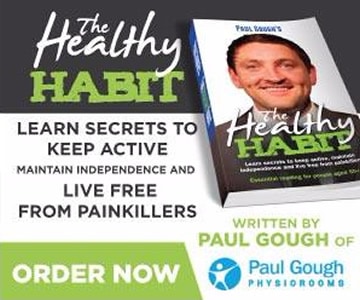Got this lovely letter from fan of my Northern Echo column recently, asking for tips to keep active and fit after recovering from a stroke:
===
“Paul, I am 64 year old. 7 months ago I suffered a stroke which affected my right side – arm, leg etc. The carers and Physio say I’m doing really well but to me it’s taking a long time. I have Physio three times per week and go to the gym twice. I try to walk with a stick but can only do a few steps. I can use the hand bike and can exercise my hands and leg.
I notice from your column you regularly give out tips… I wonder perhaps would you be kind enough to give me a few tips.
Alan. T – 64, Peterlee. Co.Durham.
===
Let me say that suffering a stroke is much more common than you think. And it can happen to people as early as forty, even thirty.
In my care right now I have a client who many readers of this column who are involved in local football will likely know. He suffered a stroke in his early 40’s and is now doing ever so well to battle back and re-gain his independence and find quality of life from an illness that often gives no warning signs or shows no signs of arriving, until it’s too late.
From this far, what I can’t do is give Alan any specific recommendations. That wouldn’t be right and nor would it be safe. But what I will do is describe to you what we do to help the client who comes to my clinic at least once per week and I’ll do it in the context and hope that any person who has been affected by a stroke, can be alerted to at least one of the techniques we use. If you think it will help you, maybe discuss it over with your own Physio and or support workers.
My client is mid 40’s. And most of his left side has been affected. His carer’s do a wonderful job of maintaining mobility and generally getting him up and keeping him going every morning. But he suffers from a lot of pain and tension in those muscles which don’t get used as much a they once did. And one of the reasons his family brings him to us is so that we can work hard with deep massage on relaxing very tight muscles that are so common after a stroke. And here’s the big tip: we always start with his “trunk”.
That means we set about massaging, rocking and mobilising the muscles around his lower back first. And that’s despite most of his problems being in places like his Achilles or hamstrings, which are shortening every day due to him spending so much time in a wheelchair. The reason why is this: If we can help loosen of those muscles around his lower back first, what happens naturally is all of the other muscles will begin to loosen off, too.
At first, my clients family would ask us to work on the obvious places like his hamstring and Achilles tendon and calf muscles, but, when we explained that massaging and loosening his spine was the best place to start as it made it easier when we got to the Achilles etc, it all made sense. And we were already beginning to make progress just by explaining this to his family so that they could do something similar at the start and end of each day.
One other thing to bear in mind for any one who is recovering from a stroke or who is involved in the care of: That progress is very often slow is true. And it’s often a battle of wills to succeed and you’re nearly always looking for tiny little improvements that when they come, you have to make a HUGE deal of and make everyone whose involved in that clients care feel part of. It can be as simple as making it from a wheelchair and onto a bed with only one person helping, instead of two.
In the case of Alan who asked the original question, it might be that his next big break through comes from finding someone to relax muscles in his right arm and right leg before and after he goes in to the gym. Slowly but surely it will make a positive difference and more quality of life may begin to return.
Alan, progress is often slow and steady. It sounds to me like you’ve got the determination to succeed you just need to keep looking for tiny little difference that added together make a significant improvement. Re-read this article and see if you can apply one or two of the “tips” to your own situation. Good luck and thank you for the kind words in the letter.

